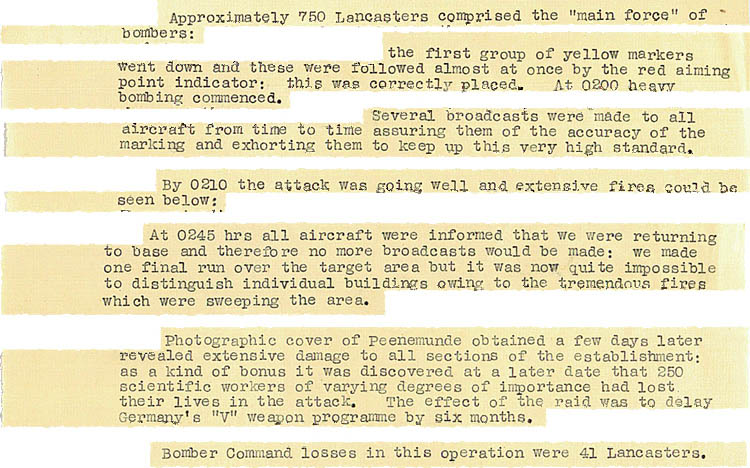Extracts from the account of the raid on Peenemunde on the night of 17-18 August 1943 by Group Captain John Searby, the Master Bomber (AIR 20/4040)
Transcript
the first group of yellow markers went down and these were followed almost at once by the red aiming point indicator: this was correctly placed. At 0200 heavy bombing commenced… …Several broadcasts were made to all aircraft from time to time assuring them of the accuracy of the marking and exhorting them to keep up this very high standard….
By 0210 the attack was going well and extensive fires could be seen below:…
At 0245 all aircraft were informed that we were returning to base and therefore no more broadcasts would be made: we made one final run over the target area but it was now quite impossible to distinguish individual buildings owing to the tremendous fires which were sweeping the area…
Photographic cover of Peenemunde obtained a few days later revealed extensive damage to all sections of the establishment: as a kind of bonus it was discovered at a later date that 250 scientific workers of varying degrees of importance had lost their lives in the attack. The effect of the raid was to delay Germany’s “V” weapon programme by six months…
Bomber Command losses in this operation were 41 Lancasters.
3. Read Source 4. This is an extract from the account of the raid on Peenemunde on the night of 17-18 August 1943 by Group Captain John Searby, the Master Bomber.
- In this account of the air raid, 250 scientific workers died. What do you feel about the killing of scientists in the attack?
- Bomber Command losses in this operation were 41 Lancasters. How many RAF men were lost if this many Lancasters were shot down? (HINT : A Lancaster had a crew of 7 men)
- According to the source, is the raid considered a success? Why/why not?
